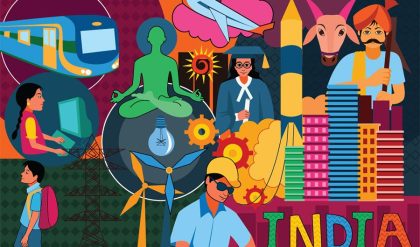According to a general survey done by the National Sample Survey Organization (NSSO), 58% of total employment exists in rural sector and only 38% in urban sector of our country. As per the estimation by the Rangarajan Panel the number of Below Poverty Line declined to 21.9% of the population in 2011-12 from 29.8% in 2009-10 and 37.2% in 2004-05. As per the Suresh Tendulkar panel’s recommendations in 2011-12, the poverty line had been fixed at Rs 27 spending in rural areas and Rs 33 in urban areas so total poverty is 21.9% at the national level.
Anti poverty measures and Employment Generating programmes are:
1. Integrated Rural Development Programme (IRDP):
The Integrated Rural Development Programme (IRDP), which was introduced in 1978-79 and universalized from 2nd October, 1980, aimed at providing assistance to the rural poor in the form of subsidy and bank credit for productive employment opportunities through successive plan periods. On 1st April, 1999, the IRDP and allied programmes were merged into a single programme known as Swarnajayanti Gram Swarozgar Yojana (SGSY). The SGSY emphasizes on organizing the rural poor into self-help groups, capacity-building, planning of activity clusters, infrastructure support, technology, credit and marketing linkages.
2. Jawahar Rozgar Yojana/Jawahar Gram Samriddhi Yojana:
Under the Wage Employment Programmes, the National Rural Employment Programme (NREP) and Rural Landless Employment Guarantee Programme (RLEGP) were started in Sixth and Seventh Plans. The NREP and RLEGP were merged in April 1989 under Jawahar Rozgar Yojana (JRY). The JRY was meant to generate meaningful employment opportunities for the unemployed and underemployed in rural areas through the creation of economic infrastructure and community and social assets. The JRY was revamped from 1st April, 1999, as Jawahar Gram Samriddhi Yojana (JGSY). It now became a programme for the creation of rural economic infrastructure with employment generation as the secondary objective.
3. Rural Housing – Indira Awaas Yojana:
The Indira Awaas Yojana (LAY) programme aims at providing free housing to Below Poverty Line (BPL) families in rural areas and main targets would be the households of SC/STs. It was first merged with the Jawahar Rozgar Yojana (JRY) in 1989 and in 1996 it broke away from JRY into a separate housing scheme for the rural poor.
4. Food for Work Programme:
The Food for Work Programme was started in 2000-01 as a component of EAS full form??. It was first launched in eight drought-affected states of Chhattisgarh, Gujarat, Himachal Pradesh, Madhya Pradesh, Orissa, Rajasthan, Maharashtra and Uttaranchal. It aims at enhancing food security through wage employment. Food grains are supplied to states free of cost, however, the supply of food grains from the Food Corporation of India (FCI) godowns has been slow.
5. Sampoorna Gramin Rozgar Yojana (SGRY):
The JGSY, EAS and Food for Work Programme were revamped and merged under the new Sampoorna Gramin Rozgar Yojana (SGRY) Scheme from 1st September, 2001. The main objective of the scheme continues to be the generation of wage employment, creation of durable economic infrastructure in rural areas and provision of food and nutrition security for the poor.
6. Mahatma Gandhi National Rural Employment Guarantee Act (MGNREGA) 2005:
It was launched on February 2, 2005. The Act provides 100 days assured employment every year to every rural household. One-third of the proposed jobs would be reserved for women. The central government will also establish National Employment Guarantee Funds. Similarly, state governments will establish State Employment Guarantee Funds for implementation of the scheme. Under the programme, if an applicant is not provided employment within 15 days s/he will be entitled to a daily unemployment allowance.
Salient features of MGNREGA are:
I. Right based framework
II. Time bound guarantee of employment
III. Labour intensive work
IV. Women empowerment
V. Transparency and accountability
VI. Adequate funding by central government
7. National Food for Work Programme:
It was launched on November 14, 2004 in 150 most backward districts of the country. The objective of the programme was to provide additional resources available under Sampoorna Grameen Rojgar Yojna. This was 100% centrally funded programme. Now this programme has been subsumed in the MGNREGA from Feb……. 2, 2006.
8. National Rural Livelihood Mission: Ajeevika (2011)
It is the skill and placement initiative of Ministry of Rural development. It is a part of National Rural Livelihood Mission (NRLM)–the mission for poverty reduction is called Ajeevika (2011). It evolves out the need to diversify the needs of the rural poor and provide them jobs with regular income on monthly basis. Self Help groups are formed at the village level to help the needy.
9. Pradhan Mantri Kaushal Vikas Yojna:
The cabinet on March 21, 2015 cleared the scheme to provide skill training to 1.4 million youth with an overall outlay of Rs. 1120 crore. This plan is implemented with the help of Ministry of Skill Development and Entrepreneurship through the National Skill Development Corporation. It will focus on fresh entrant to the labour market, especially labour market and class X and XII dropouts.
10. National Heritage Development and Augmentation Yojna (HRIDAY):
HRIDAY scheme was launched (21 Jan. 2015) to preserve and rejuvenate the rich cultural heritage of the country. This Rs. 500 crore programme was launched by Urban Development Ministry in New Delhi. Initially it is launched in 12 cities: Amritsar, Varanasi, Gaya, Puri, Ajmer, Mathura, Dwarka, Badami, Velankanni, Kanchipuram, Warangal and Amarvati.
These programmes played/are playing a very crucial role in the development of the all sections of the society so that the concept of holistic development can be ensured in the real sense.






Comments are closed.